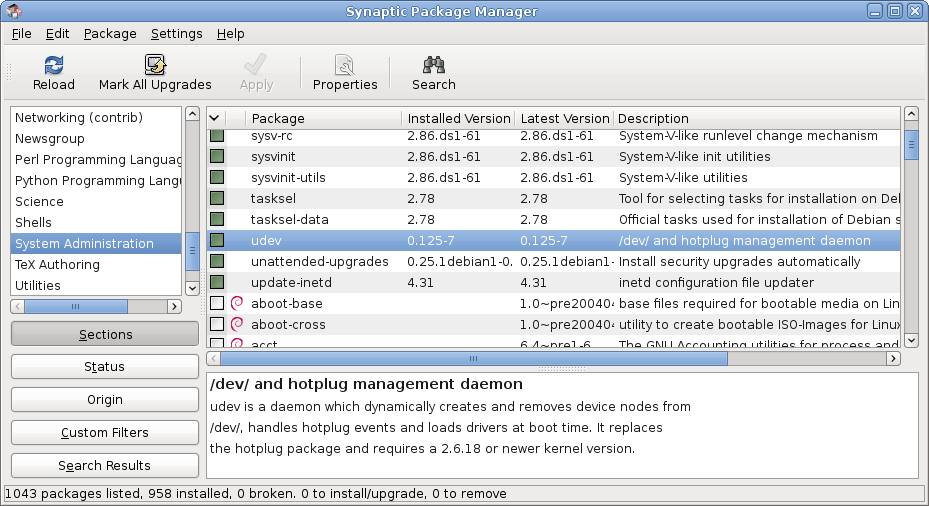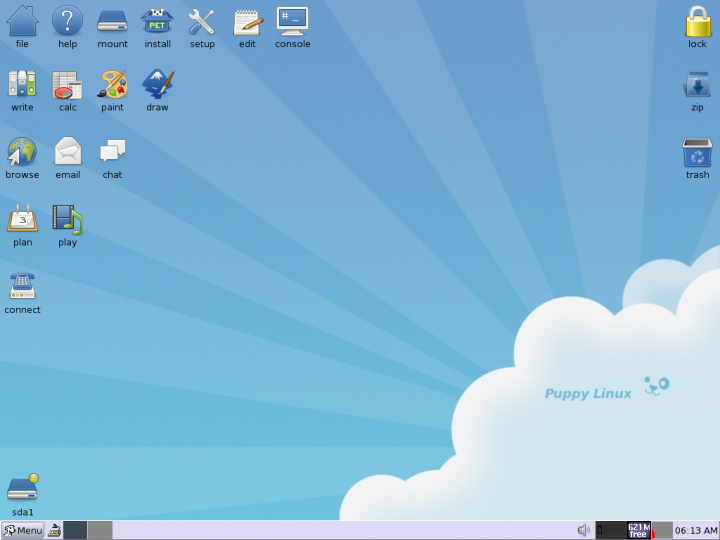|
ROX Desktop
The ROX Desktop is a graphical desktop environment for the X Window System. It is based on the ROX-Filer which is a drag and drop spatial file manager. It is free software released under the GNU General Public License. The environment was inspired by the user interface of RISC OS (not to be confused with RISC/os). The name "ROX" comes from "RISC OS on X". Programs can be installed or removed easily using Zero Install. The project was started by Thomas Leonard as a student at University of Southampton in 1999 and was still led by him in 2012. Software components The ROX Desktop is a desktop environment based on the ROX-Filer file manager. Files are loaded by applications by using drag and drop from the filer to the application, and saved by dragging back to the filer. Applications are executable directories, and are thus also installed (copied), uninstalled (deleted), and run through the filer interface. ROX has a strong link with Zero Install, a method of identifying a ... [...More Info...] [...Related Items...] OR: [Wikipedia] [Google] [Baidu] |
AntiX 21 Runit With ROX Desktop 2
antiX () is a Linux distribution based on Debian Stable. It is comparatively lightweight and suitable for older computers, while also providing cutting edge kernel and applications, as well as updates and additions via the apt-get package system and Debian-compatible repositories. antiX specifically does not ship with or support the systemd init system. SysVinit is set as the default. * Version 19 antiX offers sysVinit and runit as a choice for the init system. * Starting with version 22 antiX is offered elogind-free for both 32-bit and 64-bit architecture. Window managers antiX comes with default SpaceFM Desktop Environment (DE) built on top of GTK library and IceWM as a Window Manager. antiX-full and antiX-base include these window managers: * Lightweight: Rox-IceWM (default), IceWM and SpaceFM-IceWM. ( Stacking WM) * Minimalist: Rox-Fluxbox, Fluxbox and SpaceFM-Fluxbox. (Stacking WM) * Very minimalist: Rox-JWM, JWM and SpaceFM-JWM. (Stacking WM) Running the ROX o ... [...More Info...] [...Related Items...] OR: [Wikipedia] [Google] [Baidu] |
Application Directory
An application directory is a grouping of software code, help files and resources that together comprise a complete software package but are presented to the user as a single object. They are currently used in RISC OS and the ROX Desktop, and also form the basis of the Zero Install application distribution system. Similar technology includes VMware ThinApp, and the NEXTSTEP/GNUstep/Mac OS X macOS (; previously OS X and originally Mac OS X) is a Unix operating system developed and marketed by Apple Inc. since 2001. It is the primary operating system for Apple's Mac computers. Within the market of desktop and la ... concept of application bundles. Their heritage lies in the system for automatically launching software stored on floppy disk on Acorn Computers, Acorn's earlier 8-bit micros such as the BBC Micro (the ''!BOOT'' file). Bundling various files in this manner allows tools for manipulating applications to be replaced by tools for manipulating the f ... [...More Info...] [...Related Items...] OR: [Wikipedia] [Google] [Baidu] |
Package Manager
A package manager or package-management system is a collection of software tools that automates the process of installing, upgrading, configuring, and removing computer programs for a computer in a consistent manner. A package manager deals with ''packages'', distributions of software and data in archive files. Packages contain metadata, such as the software's name, description of its purpose, version number, vendor, checksum (preferably a cryptographic hash function), and a list of dependencies necessary for the software to run properly. Upon installation, metadata is stored in a local package database. Package managers typically maintain a database of software dependencies and version information to prevent software mismatches and missing prerequisites. They work closely with software repositories, binary repository managers, and app stores. Package managers are designed to eliminate the need for manual installs and updates. This can be particularly useful for large enterp ... [...More Info...] [...Related Items...] OR: [Wikipedia] [Google] [Baidu] |
Comparison Of X Window System Desktop Environments
A desktop environment is a collection of software designed to give functionality and a certain look and feel to an operating system. This article applies to operating systems which are capable of running the X Window System, mostly Unix and Unix-like operating systems such as Linux, Minix, illumos, Solaris, AIX, FreeBSD and Mac OS X. Microsoft Windows is incapable of natively running X applications; however, third-party X servers like Cygwin/X, Exceed, or Xming are available. Technical elements of a desktop environment A desktop environment (DE) can be broken up into several components that function independently and interact with one another to provide the look and feel and functionality of the desktop environment. A fundamental part of a DE is the window manager or WM. A window manager creates a certain way for application windows to present themselves to the user. It manages the various application windows, keeping track of which ones are open and providing features to s ... [...More Info...] [...Related Items...] OR: [Wikipedia] [Google] [Baidu] |
Toolkit
A toolkit is an assembly of tools; set of basic building units for user interfaces. The word toolkit may refer to: * Abstract Window Toolkit * Accessibility Toolkit * Adventure Game Toolkit * B-Toolkit * Battlefield Mod Development Toolkit * Cheminformatics toolkits * Dojo Toolkit * Fox toolkit * Globus Toolkit * GTK, the GIMP Toolkit * Google Web Toolkit (GWT) * Harmony (toolkit), an incomplete set of software widgets * Helsinki Finite-State Technology (HFST) * Insight Segmentation and Registration Toolkit * IT Mill Toolkit * Learnosity Toolkit * Molecular Modelling Toolkit * Multidimensional hierarchical toolkit * Sun Java Wireless Toolkit * OCR SDK, OCR Toolkit * OpenGL Utility Toolkit (GLUT) * Open Inventor 3D graphics API * Qt * Motif * Natural Language Toolkit * Portable, Extensible Toolkit for Scientific Computation * Scedu Tender Readiness Toolkit * Sprite Animation Toolkit * Standard Widget Toolkit (SWT) * Synthesis Toolkit * Template Toolkit * The Coroner's T ... [...More Info...] [...Related Items...] OR: [Wikipedia] [Google] [Baidu] |
GTK+
GTK (formerly GIMP ToolKit and GTK+) is a free and open-source cross-platform widget toolkit for creating graphical user interfaces (GUIs). It is licensed under the terms of the GNU Lesser General Public License, allowing both free and proprietary software to use it. It is one of the most popular toolkits for the Wayland and X11 windowing systems. The GTK team releases new versions on a regular basis. GTK 4 and GTK 3 are maintained, while GTK 2 is end-of-life. Software architecture The GTK library contains a set of graphical control elements ( widgets); version 3.22.16 contains 186 active and 36 deprecated widgets. GTK is an object-oriented widget toolkit written in the programming language C; it uses GObject, that is the GLib object system, for the object orientation. While GTK is mainly for windowing systems based on X11 and Wayland, it works on other platforms, including Microsoft Windows (interfaced with the Windows API), and macOS (interfaced with ... [...More Info...] [...Related Items...] OR: [Wikipedia] [Google] [Baidu] |
Thunar
Thunar is a file manager for Linux and other Unix-like systems, initially written using the GTK+ 2 toolkit and later ported to the GTK+ 3 toolkit. It started to ship with Xfce in version 4.4 RC1 and later. Thunar is developed by Benedikt Meurer, and was originally intended to replace XFFM, Xfce's previous file manager. It was initially called Filer but was changed to Thunar due to a name clash. Thunar is designed to start up faster and be more responsive than some other Linux file managers, such as GNOME Files and Konqueror. Accessibility is accomplished using GNOME Accessibility Toolkit. Like the rest of Xfce, Thunar is designed to comply with standards, such as those stated at |
Xubuntu
Xubuntu () is a Canonical Ltd.–recognized, community-maintained derivative of the Ubuntu operating system. The name ''Xubuntu'' is a portmanteau of ''Xfce'' and ''Ubuntu'', as it uses the Xfce desktop environment, instead of Ubuntu's Unity and GNOME desktop. Xubuntu seeks to provide "a light, stable and configurable desktop environment with conservative workflows" using Xfce components. Xubuntu is intended for both new and experienced Linux users. Rather than explicitly targeting low-powered machines, it attempts to provide "extra responsiveness and speed" on existing hardware. History Xubuntu was originally intended to be released at the same time as Ubuntu 5.10 ''Breezy Badger'', 13 October 2005, but the work was not complete by that date. Instead the Xubuntu name was used for the ''xubuntu-desktop'' metapackage available through the Synaptic Package Manager which installed the Xfce desktop. The first official Xubuntu release, led by Jani Monoses, appeared on 1 June 200 ... [...More Info...] [...Related Items...] OR: [Wikipedia] [Google] [Baidu] |
Puppy Linux
Puppy Linux is an operating system and family of light-weight Linux distributions that focus on ease of use and minimal memory footprint. The entire system can be run from random-access memory (RAM) with current versions generally taking up about 600 MB (64-bit), 300 MB (32-bit), allowing the boot medium to be removed after the operating system has started. Applications such as AbiWord, Gnumeric and MPlayer are included, along with a choice of lightweight web browsers and a utility for downloading other packages. The distribution was originally developed by Barry Kauler and other members of the community, until Kauler retired in 2013. The tool Woof can build a Puppy Linux distribution from the binary packages of other Linux distributions. History Barry Kauler started Puppy Linux in response to a trend of other distributions becoming stricter on system requirements over time. His own distribution, with an emphasis on speed and efficiency and being lightweight, started from "Boot ... [...More Info...] [...Related Items...] OR: [Wikipedia] [Google] [Baidu] |
Linux Distribution
A Linux distribution (often abbreviated as distro) is an operating system made from a software collection that includes the Linux kernel and, often, a package management system. Linux users usually obtain their operating system by downloading one of the Linux distributions, which are available for a wide variety of systems ranging from embedded devices (for example, OpenWrt) and personal computers (for example, Linux Mint) to powerful supercomputers (for example, Rocks Cluster Distribution). A typical Linux distribution comprises a Linux kernel, GNU tools and libraries, additional software, documentation, a window system (the most common being the X Window System, or, more recently, Wayland), a window manager, and a desktop environment. Most of the included software is free and open-source software made available both as compiled binaries and in source code form, allowing modifications to the original software. Usually, Linux distributions optionally include some proprietary so ... [...More Info...] [...Related Items...] OR: [Wikipedia] [Google] [Baidu] |
File Manager
A file manager or file browser is a computer program that provides a user interface to manage files and folders. The most common operations performed on files or groups of files include creating, opening (e.g. viewing, playing, editing or printing), renaming, copying, moving, deleting and searching for files, as well as modifying file attributes, properties and file permissions. Folders and files may be displayed in a hierarchical tree based on their directory structure. Features File transfer Graphical file managers may support copying and moving of files through "copy and paste" and "cut and paste" respectively, as well as through drag and drop, and a separate menu for selecting the target path. While transferring files, a file manager may show the source and destination directories, transfer progress in percentage and/or size, progress bar, name of the file currently being transferred, remaining and/or total number of files, numerical transfer rate, and graphical ... [...More Info...] [...Related Items...] OR: [Wikipedia] [Google] [Baidu] |





